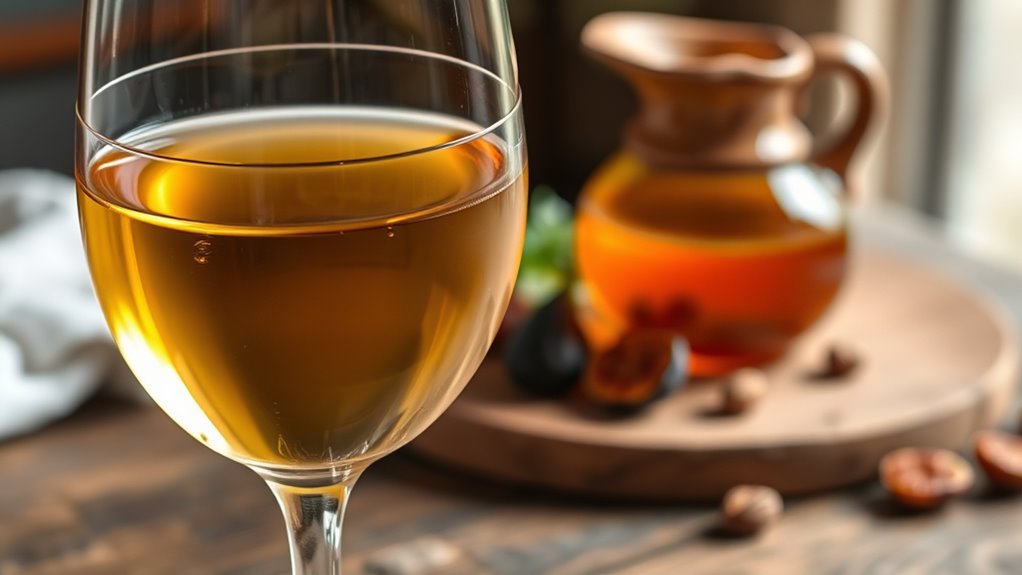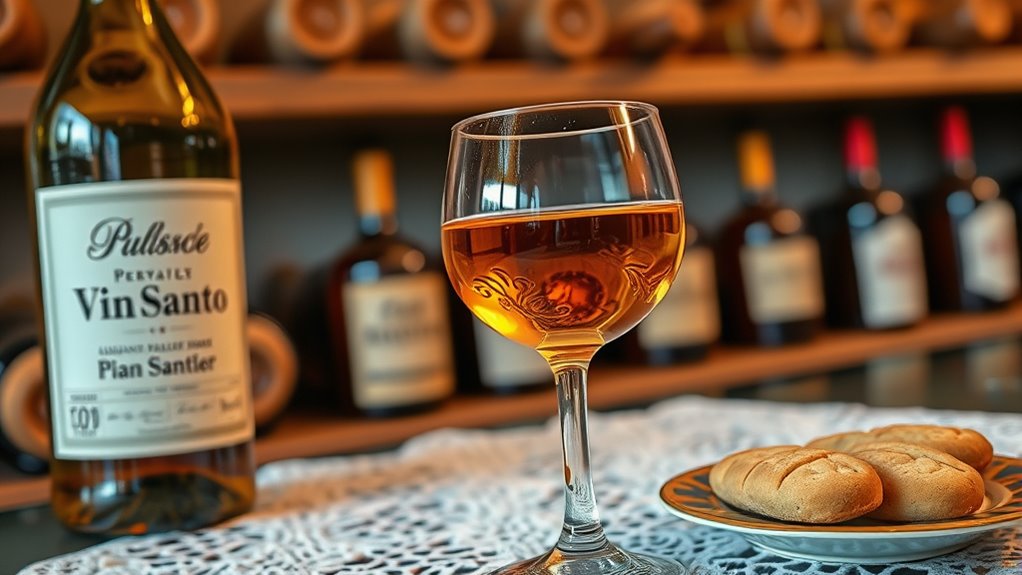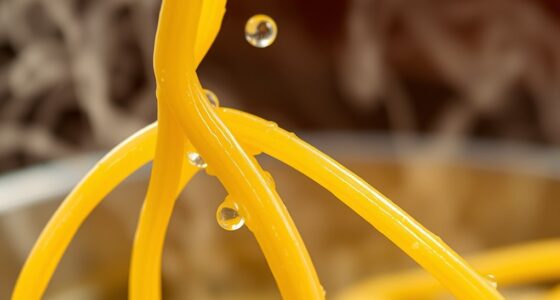Italian dessert wines like Passito and Vin Santo are crafted through traditional drying and aging methods. You’ll see grapes laid on straw mats or hung in ventilated rooms, which concentrates sugars and flavors over weeks or months. These wines age in oak or terracotta vessels, developing complex notes of dried fruit, nuts, and honey. To understand how these techniques shape their rich profiles and heritage, explore further into their unique production methods.
Key Takeaways
- Passito and Vin Santo are traditional Italian dessert wines made from dried grapes, concentrating sugars and flavors.
- Grapes are dried using techniques like appassimento or on mats, enhancing sweetness and complexity.
- Vin Santo is typically aged in small oak barrels called caratelli, developing rich, layered flavors over time.
- The drying and aging processes are carefully managed to balance sweetness, acidity, and aromatic intensity.
- These wines showcase Italy’s craftsmanship, blending tradition, patience, and specific techniques to create unique dessert wines.

Have you ever wondered what makes Italian dessert wines so enthralling? It all begins with the unique methods used to craft these wines, especially the grape drying techniques and aging process methods. In Italy, winemakers take special care to develop concentrated flavors by carefully drying grapes, which considerably influences the wine’s richness and sweetness. Grape drying techniques vary depending on the region and desired outcome. For example, in the production of Vin Santo, grapes are traditionally laid out on straw mats or hung in well-ventilated rooms to slowly lose water content. This process, called appassimento, can last several weeks to months, allowing the grapes to develop intense sugars and complex flavors. Similarly, in the production of Passito wines, grapes are often dried on mats or in special drying chambers, ensuring controlled dehydration that enhances sweetness without compromising balance. These drying methods are crucial because they concentrate sugars and flavors, resulting in a wine that’s both luscious and layered.
Once the grapes reach the desired level of ripeness and concentration, winemakers move on to the aging process methods, which further shape the character of the wine. For Passito wines, aging can take place in a variety of vessels—stainless steel, large oak casks, or even terracotta—each imparting subtle influences to the final product. Vin Santo, on the other hand, is traditionally aged in small oak barrels called caratelli, where the wine develops complexity over time. The aging process can span from a few years to decades, allowing the wine to mellow and its flavors to deepen. During this time, the wine gains desirable notes of dried fruit, nuts, honey, and spices. The environment where aging occurs—temperature, humidity, and contact with wood—plays a crucial role in shaping the wine’s final profile. Some producers opt for extended aging to create a more nuanced, refined wine, while others prefer shorter periods to preserve freshness and vibrancy.
In essence, the charm of Italian dessert wines like Passito and Vin Santo hinges on these meticulous techniques. The grape drying methods ensure the perfect concentration of sugars and flavors, while the aging process methods allow those flavors to mature gracefully. When you sip these wines, you’re tasting the culmination of careful craftsmanship and tradition—an intricate dance of patience, skill, and passion. It’s this delicate balance that makes Italian dessert wines so captivating, offering a sensory journey into the heart of Italy’s winemaking heritage.
Frequently Asked Questions
How Is the Sweetness Level of Passito and Vin Santo Determined?
You determine the sweetness level of passito and vin santo through sugar concentration measurement and sweetness perception evaluation. By measuring the residual sugar content, you get an objective idea of their sweetness. Additionally, you assess how sweet they taste to the palate, considering factors like acidity and alcohol. Combining these methods helps you accurately gauge the wines’ sweetness, ensuring you understand their rich, balanced profiles.
What Are the Ideal Food Pairings for Italian Dessert Wines?
Think of Italian dessert wines as the star of a symphony, harmonizing with sweet and savory notes. You should pair them with cheese pairings like aged Parmesan or creamy Gorgonzola, which balance their richness. Fruit accompaniments such as figs, pears, or dried apricots enhance the flavors. These wines shine brightest when served alongside desserts like biscotti or almond cake, creating a perfect melody of taste on your palate.
Can Passito and Vin Santo Be Aged for Decades?
You can age Passito and Vin Santo for decades if you understand their aging potential and use proper storage techniques. These wines develop complex flavors over time, so storing them in a cool, dark, and consistent environment is essential. Keep bottles upright initially, then lay them on their side to guarantee the cork stays moist. With careful aging, you’ll enjoy richer, more nuanced wines that reward patience.
Are There Regional Differences in Production Methods Within Italy?
You’ll find regional differences in Italy’s dessert wine production methods due to diverse regional grape varieties and strict production regulations. In Tuscany, Vin Santo is traditionally made with Trebbiano and Malvasia grapes, while Puglia uses different varieties. These variations influence flavor profiles and aging practices. Local regulations guarantee quality and authenticity, so each region’s unique approach shapes the character of their Passito and Vin Santo wines.
How Should Italian Dessert Wines Be Stored for Optimal Aging?
Imagine you’ve just bought a bottle of Vin Santo; proper storage techniques are vital for aging. Store it in a cool, dark place away from direct sunlight and temperature fluctuations. Use quality aging containers like glass bottles with airtight corks to prevent oxidation. Keep the bottle upright to limit cork contact with the wine, ensuring it ages gracefully and maintains its rich, complex flavors over time.
Conclusion
Italian dessert wines like Passito and Vin Santo offer a sweet, rich experience you won’t forget. Did you know Italy produces over 20 million liters of these luscious wines annually? Whether you’re savoring them with dessert or on their own, they bring a unique taste of Italy’s centuries-old tradition. Next time you sip one, you’ll appreciate not just the flavor, but the rich history behind each glass. Cheers to discovering Italy’s sweet side!









